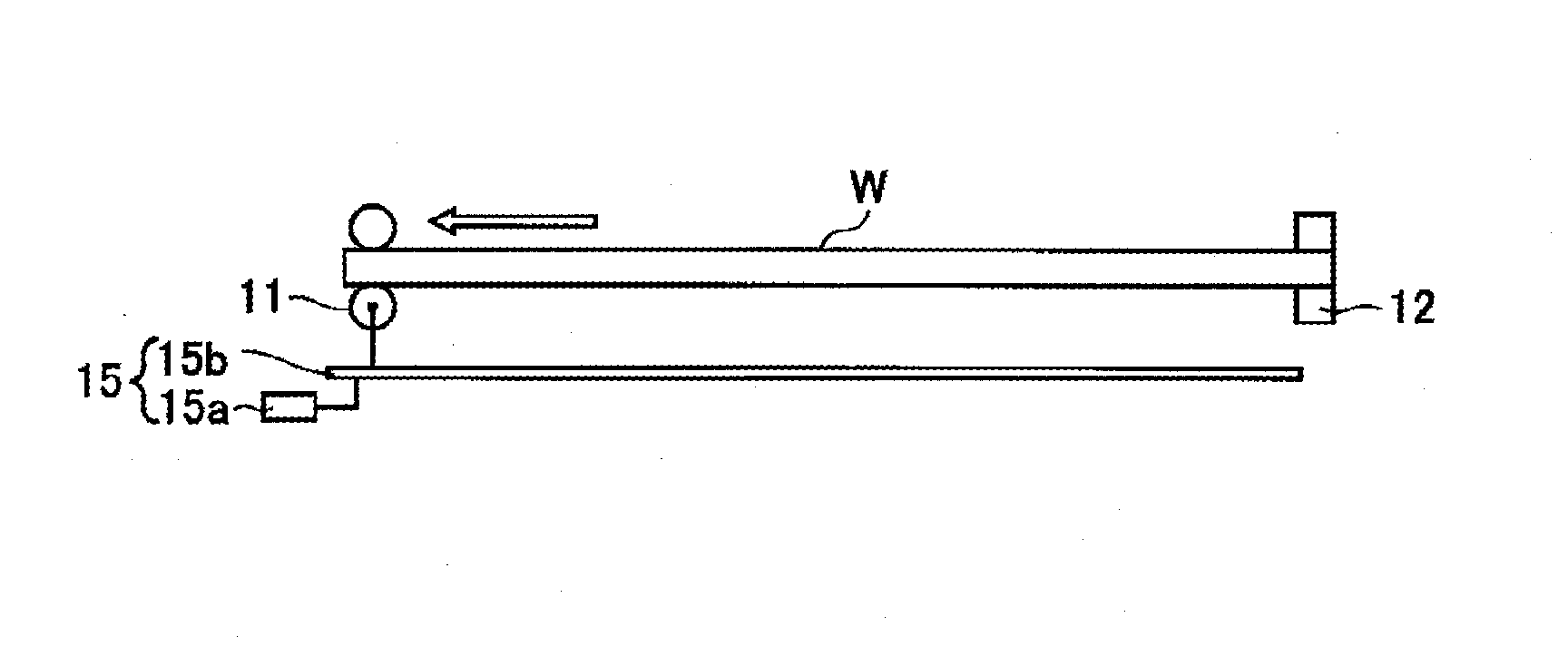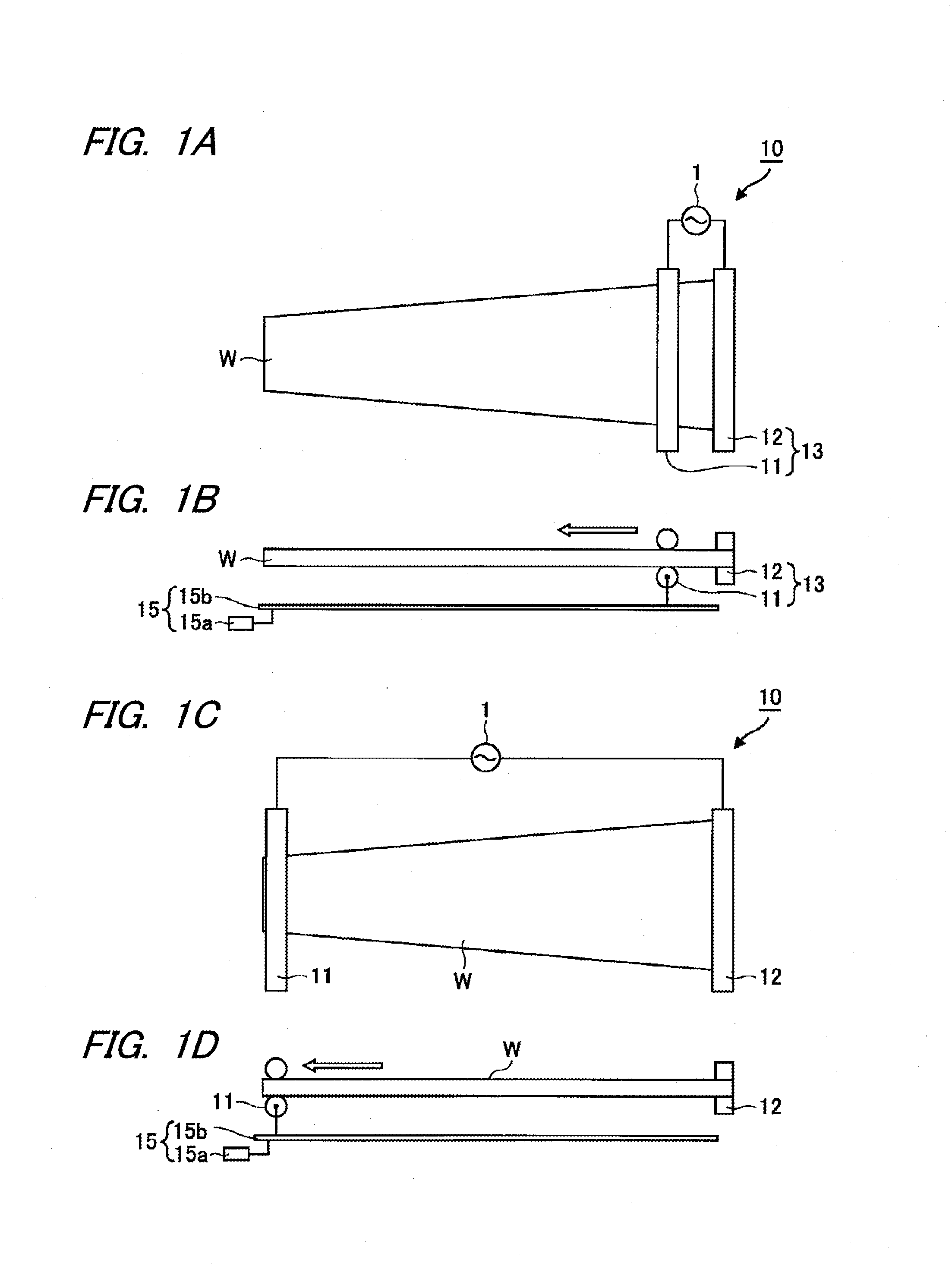Current applying apparatus, current applying method and direct resistance heating apparatus
- Summary
- Abstract
- Description
- Claims
- Application Information
AI Technical Summary
Benefits of technology
Problems solved by technology
Method used
Image
Examples
first embodiment
MODIFICATION OF FIRST EMBODIMENT
[0083]Although an example of using one electrode of the pair of electrodes 13 as the moving electrode 11 has been described in the first embodiment, both electrodes of the pair of electrodes 13 may be configured as the moving electrodes 11, 11, as shown in FIG. 4. In this case, the bus bars 25, 25 are separately provided so as to correspond to the moving range of both electrodes 11, 11 and respectively configure the current applying apparatus 20 as described above. Then, the heating target region is heated by moving both electrodes 11, 11 in a direction away from each other from the adjacent position in a state where voltage is applied between both bus bars 25, 25. Also in this current applying apparatus, the same operational effects as those described above can be obtained.
ANOTHER MODIFICATION OF FIRST EMBODIMENT
[0084]FIG. 5 shows another modification of the first embodiment.
[0085]In the first embodiment, the power feeding roller 41 is mounted on the...
second embodiment
MODIFICATION OF SECOND EMBODIMENT
[0125]Although an example of using one electrode of the pair of electrodes 13 as the moving electrode 11 has been described in the second embodiment, both electrodes of the pair of electrodes 13 may be configured as the moving electrodes 11, 11, as shown in FIG. 9. In this case, the bus bars 25 and the electrically-conductive brushes 45 are separately provided so as to correspond to the moving range of both electrodes 11, 11 and respectively configure the current applying apparatus 20 as described above. Then, the heating target region is heated by moving both electrodes 11, 11 in a direction away from each other from the adjacent position in a state where voltage is applied between both bus bars 25. Also in this current applying apparatus 20, the same operational effects as those described above can be obtained.
THIRD EMBODIMENT
[0126]As shown in FIG. 10 and FIG. 11, the direct resistance heating apparatus 10 of the third embodiment includes the power...
third embodiment
MODIFICATION OF THIRD EMBODIMENT
[0159]Although one electrode of the pair of electrodes 13 has been used as the moving electrode 11 in the third embodiment, both electrodes of the pair of electrodes 13 may be configured as the moving electrodes 11, 11, as shown in FIG. 12. In this case, the bus bars 25, 25 are separately provided so as to correspond to the moving range of both electrodes 11, 11 and respectively configure the current applying apparatus 20 as described above. Then, the heating target region is heated by moving both electrodes 11, 11 in a direction away from each other from the adjacent position in a state where voltage is applied between both bus bars 25, 25. Also in this current applying apparatus 20, the same operational effects as those described above can be obtained.
[0160]Further, although the current-applying roller 23 and the power feeding roller 41 are mounted on the same shaft in the third embodiment, the current-applying roller 23 and the power feeding roller...
PUM
| Property | Measurement | Unit |
|---|---|---|
| Length | aaaaa | aaaaa |
| Current | aaaaa | aaaaa |
| Electrical conductor | aaaaa | aaaaa |
Abstract
Description
Claims
Application Information
 Login to view more
Login to view more - R&D Engineer
- R&D Manager
- IP Professional
- Industry Leading Data Capabilities
- Powerful AI technology
- Patent DNA Extraction
Browse by: Latest US Patents, China's latest patents, Technical Efficacy Thesaurus, Application Domain, Technology Topic.
© 2024 PatSnap. All rights reserved.Legal|Privacy policy|Modern Slavery Act Transparency Statement|Sitemap



